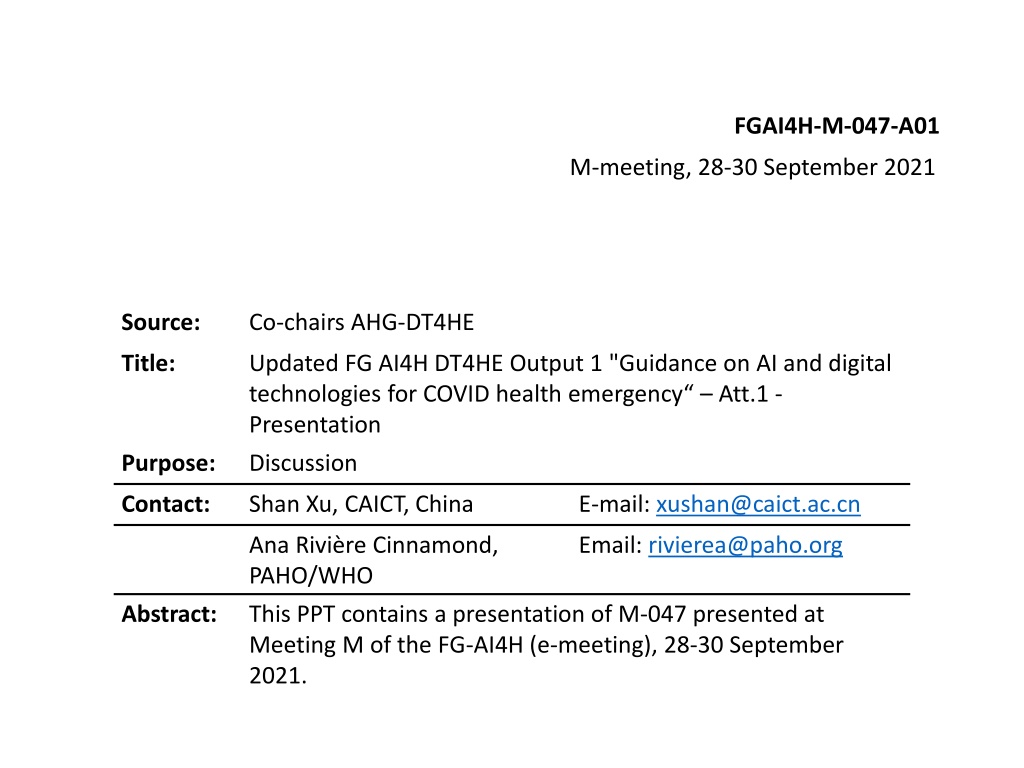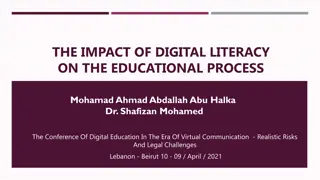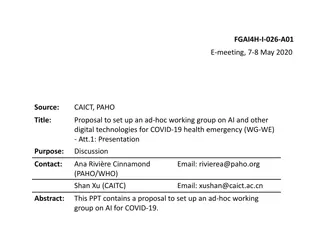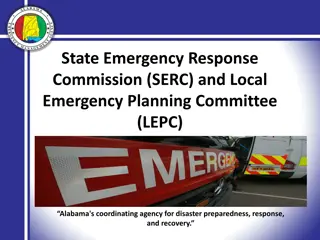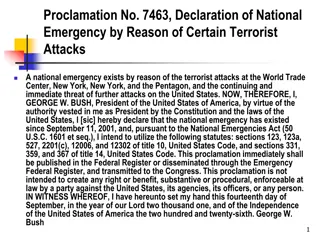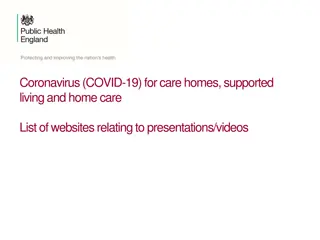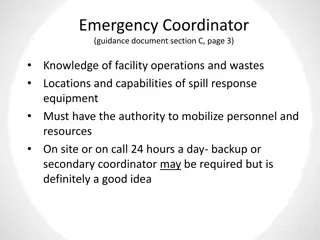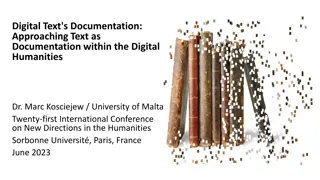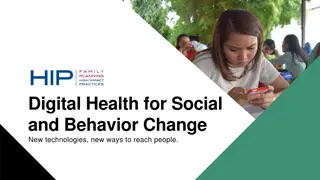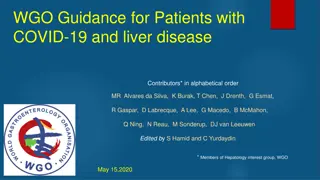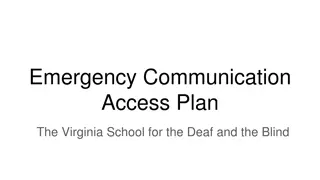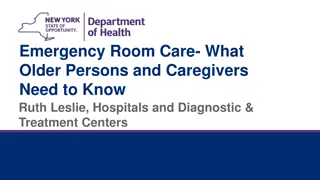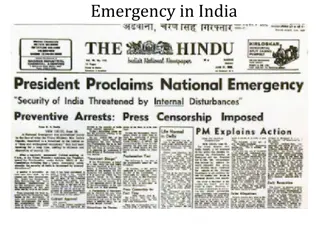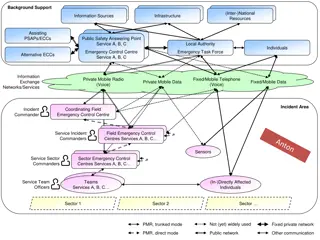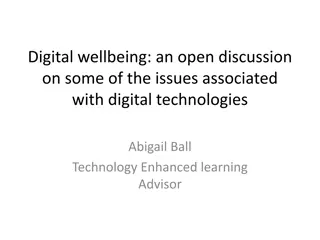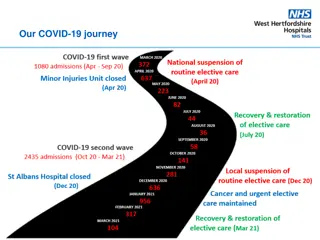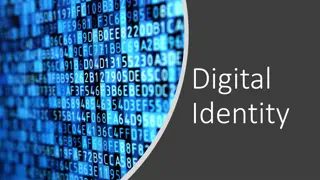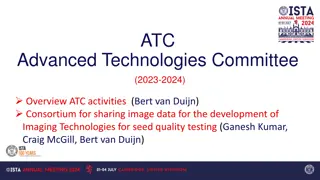Guidance on AI and Digital Technologies for COVID Health Emergency
This presentation focuses on providing guidance on utilizing AI and digital technologies for managing health emergencies, specifically the COVID-19 pandemic. It includes information on the AHG-DT4HE roadmap, mechanisms for expert collaboration, enablement factors such as prevention, preparedness, and support systems for healthcare services.
Download Presentation

Please find below an Image/Link to download the presentation.
The content on the website is provided AS IS for your information and personal use only. It may not be sold, licensed, or shared on other websites without obtaining consent from the author. Download presentation by click this link. If you encounter any issues during the download, it is possible that the publisher has removed the file from their server.
E N D
Presentation Transcript
FGAI4H-M-047-A01 M-meeting, 28-30 September 2021 Source: Co-chairs AHG-DT4HE Title: Updated FG AI4H DT4HE Output 1 "Guidance on AI and digital technologies for COVID health emergency Att.1 - Presentation Purpose: Discussion Contact: Shan Xu, CAICT, China E-mail: xushan@caict.ac.cn Ana Rivi re Cinnamond, PAHO/WHO This PPT contains a presentation of M-047 presented at Meeting M of the FG-AI4H (e-meeting), 28-30 September 2021. Email: rivierea@paho.org Abstract:
Guidance on digital technologies for COVID health emergency AHG-DT4HE: Ad-hoc group on digital technologies for COVID health emergency
Introduction 3 WHO Coronavirus Disease (COVID-19) Dashboard, https://covid19.who.int/
AHG-DT4HE Roadmap Long-term This document evolves towards a more generalizable framework on the health emergency continuum, applicable to other health emergencies, and contributes to global digital public health. Mid-term To summarize experience extracted from COVID-19. Short term To deliver a guidance on digital technologies-based approach that cover the entire cycle of public health emergency management. A mechanism to collect effective experience on AI and other digital health technologies in combating COVID-19, including: -use cases -best practice -experts network 4 Ad-hoc Group on Digital Technologies for COVID Health Emergencies , https://www.itu.int/en/ITU-T/focusgroups/ai4h/Pages/dt4he.aspx
Mechanism Experts Affiliation Weekly con-call: Ananya Gangavarapu Ethicallyai UNITED NATIONS. ISOC/ICANN. FIBREE FOUNDATION 22 meetings have been held every Mondays at 3:00pm Washington DC time (EST) since Jun 12 Andrea Romaoli Garcia The N.1 Institute for Health (N.1)/The Institute for Digital Medicine (WisDM) Dean Ho Electronics and Telecommunications Research Institute (ETRI) Collaboration site: Jonghong Jeon Kirmene Marzouki SPIKE-X https://extranet.itu.int/sites/itu- t/focusgroups/ai4h/SitePages/AHG- DT4HE.aspx Mo Murhaba Independent Nejma Cheikh World Bank Patricia Mechael Health Enabled Documents: Pradeep Balachandran Riviere-Cinnamond, Dra. Ana Independent Consultancy Continuous iteration on the Guidance on digital technologies for COVID health emergency Pan American Health Organization Shan Xu China Academy of Information Technology Shariful Islam Deakin University Wasswa William Mbarara University of Science and Technology Zara Shubber World Bank 5
Enablement Factors Prevention Early detection Early screening systems e.g. point- of-entry syndrome screening Surveillance Information Information publication platform or dashboard Fight misinformation Contact tracing AI-powered epidemiological models Network Wireless Communication, Internet, and Routers. Preparedness Training Personnel capacity building (professional development for health workers) Supply Emergency supply chain management system Living Support Data resource Emergency support for life necessities and mental health Data Resource, storage, curation, and integration to data repositories Medical waste system Healthcare service Virtual assistants, chatbots, online service Medical imaging auxiliary diagnosis Delivery R&D Developments of drugs and vaccines Response Computing capability Contactless delivery Disinfection robot Smartphones, Edge devices, Elastic Cloud Resources Algorithm Monitor Recovery Supervised, unsupervised, and reinforcement learning. Treatment monitoring Service monitoring Economic monitoring Digital governance Evaluation Criteria governance factors on AI and other digital interventions in health emergencies. measures and indicators to evaluate the performance and applicability. 6 AI applications at different stages of the COVID-19 response (adapted from OECD)
Current activities 1. Case collection: A. Already collected information on DT used in the context of the COVID-19 emergency cycle; B. Continue the collection of typical cases in different countries and regions by designing a questionnaire to collect further information.
A - Case Collection Canada, 1 case Danish, 1 case UK, 3 cases UAE, 1 case Japan, 1 case USA, 6 cases China, 11 cases Saudi, 1 case India, 1 case Australia, 1 case 8 27 cases in the current stage, the collection will continue
B - Questionnaire Purpose: This survey is aimed at a preliminary assessment of the technological requirements needed for building an effective AI enabled pandemic response digital health strategy in low- and middle- income countries (LMICs). The outcome of this survey analysis is intended at serving the Ministries of Health (MoHs) in LMICs with necessary guidelines to forecast, plan and execute effective AI enabled digital health capabilities for health emergency response. 9
Next Steps Technical Enablement: identify minimum set of requirements for the technical enablement components such as network, data resource, computing capacities, etc. Digital governance: considers governance factors on AI and other digital interventions on COVID-19 and other health emergencies. Outcome Evaluation: Contains measures and indicators to evaluate the outcome and applicability of different AI and digital interventions. 10
Thank you contact rivierea@paho.org, xushan@caict.ac.cn 11
Annex: How AHG serves FG & TGs To give a broader landscape and integration of AI4H or DT4H on public health perspective TG-Outbreaks TG-Symptom Enablement Factors Early detection Early screening systems e.g. point-of-entry syndrome screening Surveillance Contact tracing AI-powered epidemiological models Information Information publication platform or dashboard Fight misinformation Prevention Network Wireless Communication, Internet, and Routers. Training Supply Living Support Preparedness Data resource Personnel capacity building (professional development for health workers) Emergency supply chain Emergency support for life necessities and mental health Data Resource, storage, curation, and integration to data repositories Medical waste system TG-DiagnosticCT, TG-Histo, TG-Radiology Healthcare service Virtual assistants, chatbots, online service Medical imaging diagnosis Delivery Contactless delivery Disinfection robot R&D Developments of drugs and vaccines Computing capability Smartphones, Edge devices, Elastic Cloud Resources Response Algorithm Monitor Treatment monitoring Service monitoring Economic monitoring Recovery Supervised, unsupervised, and reinforcement learning. Digital governance governance factors on AI and other digital interventions in health emergencies. Evaluation Criteria measures and indicators to evaluate the performance and applicability. 12
